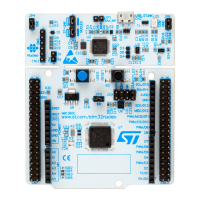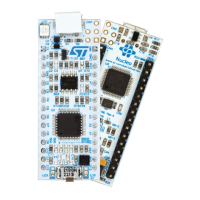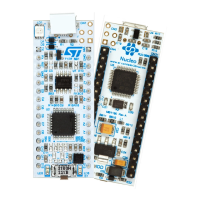UM2206 Rev 3 27/55
UM2206 Hardware layout and configuration
54
LD1 COM: LD1 is a bi-color LED. LD1 default status is red. LD1 turns to green to indicate
that communication is in progress between the PC and the ST-LINK/V2-1 as follow:
• Slow blinking red/off: at power-on before USB initialization
• Fast blinking red/off: after the first correct communication between the PC and the
ST-LINK/V2-1 (enumeration)
• Red LED on: when initialization between the PC and the ST-LINK/V2-1 is successfully
ended
• Green LED on: after successful STM32 communication initialization
• Blinking red/green: during communication with STM32
• Green on: communication well ended
• Orange on: communication ended with failure
LD2: 5V_USB: this red LED switch ON when overcurrent is detected on USB V
BUS
. The
LED gives the information that more than 500
mA is requested on V
BUS
. In this case it is
recommended to supply the board by E5V, V
IN
or in USB_CHARGER mode.
LD3: 5V_PWR: this green LED is ON when the STM32 Nucleo-64-P board is powered by a
5
V source.
LD4 USER: this green LED is a user LED connected to Arduino signal D13 corresponding
to STM32 I/O PB13. To light the LED a high-logic state “1” has to be written in the
corresponding GPIO. A transistor is used to drive the LED when the I/O voltage is 1.8
V.
LD4 consumption does not impact the V
DD
STM32 power measurement, since LD4 is
isolated from it.
9.11 Push buttons
Two buttons are available on the STM32 Nucleo-64-P board.
• B1 USER: the blue button for user and wake-up function is connected to the I/O PC13
(default) or to I/O PA0 (optional) of the STM32. When the button is depressed the logic
state is “1”, otherwise the logic state is “0”.
• B2 RESET: the black button is connected to NRST and is used to RESET the STM32.
When the button is depressed the logic state is “0”, otherwise the logic state is “1”.
The blue and black plastic hats placed on these push-buttons can be removed if necessary
when a shield or an application board is plugged on top of the STM32 Nucleo-64-P board.
This is to avoid pressure on the buttons and consequently a possible permanent STM32
RESET.
9.12 IDD measurement
The jumper JP6, labeled IDD, is used to measure the STM32 microcontroller, the level
shifter and the SMPS consumptions (depending on solder-bridge configuration), by
removing the jumper and by connecting a multimeter:
• Jumper ON: directly powered (default)
• Jumper OFF: a multimeter or an external 3.3 V power source must be connected to
measure the consumption
Note: The STM32 Nucleo-64-P board LEDs are connected before the jumper. The LED
consumptions do not impact the V
DD_MCU
power measurement.
Downloaded from Arrow.com.Downloaded from Arrow.com.Downloaded from Arrow.com.Downloaded from Arrow.com.Downloaded from Arrow.com.Downloaded from Arrow.com.Downloaded from Arrow.com.Downloaded from Arrow.com.Downloaded from Arrow.com.Downloaded from Arrow.com.Downloaded from Arrow.com.Downloaded from Arrow.com.Downloaded from Arrow.com.Downloaded from Arrow.com.Downloaded from Arrow.com.Downloaded from Arrow.com.Downloaded from Arrow.com.Downloaded from Arrow.com.Downloaded from Arrow.com.Downloaded from Arrow.com.Downloaded from Arrow.com.Downloaded from Arrow.com.Downloaded from Arrow.com.Downloaded from Arrow.com.Downloaded from Arrow.com.Downloaded from Arrow.com.Downloaded from Arrow.com.
